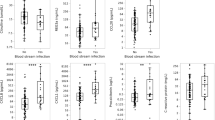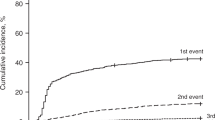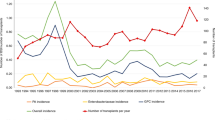Abstract
Earlier studies have suggested that severe intestinal mucositis (IM; citrulline < 10 µmol/L) is an independent risk factor for bloodstream infections (BSI) after cytotoxic therapy. Our aim was to grade IM in patients receiving commonly used chemotherapy and conditioning regimens, and characterize its relationship with BSI incidence. In a retrospective analysis of remission induction (RI) chemotherapy, or conditioning for autologous and allogeneic hematopoietic stem cell transplantation (HSCT; myeloablative conditioning [MAC] and non-myeloablative and reduced-intensity conditioning [NMA/RIC]), data were collected on central venous catheter (CVC) characteristics and BSI. The relationship between BSI occurrence and the degree of IM (determined by citrulline levels) and neutropenia was analyzed. In 626 CVC episodes, 268 (42.8%) laboratory-confirmed BSIs (LCBIs) occurred, classified as mucosal barrier injury (MBI)-LCBIs in 179 (28.6%) episodes, central line–associated BSIs in 113 (18.1%) episodes, and catheter-related BSIs in 55 (8.8%) episodes. In NMA/RIC, the mean duration of hypocitrullinemia was 0.77 days, with LCBI and MBI-LCBI occurring in 11.1% and 4.8% of episodes. In autologous HSCT, RI, and MAC allogeneic HSCT, LCBI and MBI-LCBI occurred frequently (40.0–63.8% and 22.8–53.2% of episodes, respectively) and the mean duration of hypocitrullinemia was significantly higher (9.2–13.8 days). There was a strong correlation between LCBI and the duration of hypocitrullinemia (Pearson’s correlation coefficient R = 0.96), as opposed to the relationship between LCBI and the duration of neutropenia (R = 0.42). We conclude that citrulline can be used to grade BSI risk for commonly used intensive treatment regimens.

This is a preview of subscription content, access via your institution
Access options
Subscribe to this journal
Receive 12 print issues and online access
$259.00 per year
only $21.58 per issue
Buy this article
- Purchase on Springer Link
- Instant access to full article PDF
Prices may be subject to local taxes which are calculated during checkout




Similar content being viewed by others
References
Dandoy CE, Ardura MI, Papanicolaou GA, Auletta JJ. Bacterial bloodstream infections in the allogeneic hematopoietic cell transplant patient: new considerations for a persistent nemesis. Bone Marrow Transpl. 2017;52:1091–106.
Richters A, van Vliet M, Peer PG, Verweij PE, Laros-van Gorkom BAP, Blijlevens NMA. et al. Incidence of and risk factors for persistent gram-positive bacteraemia and catheter-related thrombosis in haematopoietic stem cell transplantation. Bone Marrow Transpl. 2014;49:264–9.
Ustun C, Young J-AH, Papanicolaou GA, Kim S, Ahn KW, Chen M, et al. Bacterial blood stream infections (BSIs), particularly post-engraftment BSIs, are associated with increased mortality after allogeneic hematopoietic cell transplantation. Bone Marrow Transpl. 2019;54:1254–65.
Dandoy CE, Haslam D, Lane A, Jodele S, Demmel K, El-Bietar J, et al. Healthcare burden, risk factors, and outcomes of mucosal barrier injury laboratory-confirmed bloodstream infections after stem cell transplantation. Biol Blood Marrow Transpl. 2016;22:1671–7.
Verlinden A, Mikulska M, Knelange NS, Averbuch D, Styczynski J. Current antimicrobial practice in febrile neutropenia across Europe and Asia: the EBMT Infectious Disease Working Party survey. Bone Marrow Transpl. 2020;55:1588–94.
Kelly MS, Ward DV, Severyn CJ, Arshad M, Heston SM, Jenkins K, et al. Gut colonization preceding mucosal barrier injury bloodstream infection in pediatric hematopoietic stem cell transplantation recipients. Biol Blood Marrow Transpl. 2019;25:2274–80.
Rashidi A, Kaiser T, Graiziger C, Holtan SG, Rehman TU, Weisdorf DJ, et al. Specific gut microbiota changes heralding bloodstream infection and neutropenic fever during intensive chemotherapy. Leukemia. 2020;34:312–6.
Holler E, Butzhammer P, Schmid K, Hundsrucker C, Koestler J, Peter K, et al. Metagenomic analysis of the stool microbiome in patients receiving allogeneic stem cell transplantation: loss of diversity is associated with use of systemic antibiotics and more pronounced in gastrointestinal graft-versus-host disease. Biol Blood Marrow Transpl. 2014;20:640–5.
Peled JU, Gomes ALC, Devlin SM, Littmann ER, Taur Y, Sung AD, et al. Microbiota as predictor of mortality in allogeneic hematopoietic-cell transplantation. N. Engl J Med. 2020;382:822–34.
van Vliet MJ, Harmsen HJ, de Bont ES, Tissing WJ. The role of intestinal microbiota in the development and severity of chemotherapy-induced mucositis. PLoS Pathog. 2010;6:e1000879.
van Vliet MJ, Tissing WJ, Dun CA, Meessen NE, Kamps WA, de Bont ES, et al. Chemotherapy treatment in pediatric patients with acute myeloid leukemia receiving antimicrobial prophylaxis leads to a relative increase of colonization with potentially pathogenic bacteria in the gut. Clin Infect Dis. 2009;49:262–70.
Jenq RR, Ubeda C, Taur Y, Menezes CC, Khanin R, Dudakov JA, et al. Regulation of intestinal inflammation by microbiota following allogeneic bone marrow transplantation. J Exp Med. 2012;209:903–11.
Shono Y, Docampo MD, Peled JU, Perobelli SM, Velardi E, Tsai JJ, et al. Increased GVHD-related mortality with broad-spectrum antibiotic use after allogeneic hematopoietic stem cell transplantation in human patients and mice. Sci Transl Med. 2016;8:339ra371.
Shono Y, van den Brink MRM. Gut microbiota injury in allogeneic haematopoietic stem cell transplantation. Nat Rev Cancer. 2018;18:283–95.
Taur Y, Jenq RR, Perales MA, Littmann ER, Morjaria S, Ling L, et al. The effects of intestinal tract bacterial diversity on mortality following allogeneic hematopoietic stem cell transplantation. Blood. 2014;124:1174–82.
Taur Y, Xavier JB, Lipuma L, Ubeda C, Goldberg J, Gobourne A, et al. Intestinal domination and the risk of bacteremia in patients undergoing allogeneic hematopoietic stem cell transplantation. Clin Infect Dis. 2012;55:905–14.
Rashidi A, Kaiser T, Graiziger C, Holtan SG, Rehman TU, Weisdorf DJ, et al. Gut dysbiosis during antileukemia chemotherapy versus allogeneic hematopoietic cell transplantation. Cancer. 2020;126:1434–47.
Centers for Disease Control and Prevention. Bloodstream Infection Event (Central line-associated bloodstream infection and non-central line-associated bloodstream infection), 2020. https://www.cdc.gov/nhsn/pdfs/pscmanual/4psc_clabscurrent.pdf.
Metzger KE, Rucker Y, Callaghan M, Churchill M, Jovanovic BD, Zembower TR, et al. The burden of mucosal barrier injury laboratory-confirmed bloodstream infection among hematology, oncology, and stem cell transplant patients. Infect Control Hosp Epidemiol. 2015;36:119–24.
See I, Soe MM, Epstein L, Edwards JR, Magill SS, Thompson ND. Impact of removing mucosal barrier injury laboratory-confirmed bloodstream infections from central line-associated bloodstream infection rates in the National Healthcare Safety Network, 2014. Am J Infect Control. 2017;45:321–3.
Harris AC, Young R, Devine S, Hogan WJ, Ayuk F, Bunworasate U, et al. International, multicenter standardization of acute graft-versus-host disease clinical data collection: a report from the mount sinai acute GVHD International Consortium. Biol Blood Marrow Transpl. 2016;22:4–10.
Spyridonidis A, Labopin M, Savani BN, Niittyvuopio R, Blaise D, Craddock C, et al. Redefining and measuring transplant conditioning intensity in current era: a study in acute myeloid leukemia patients. Bone Marrow Transpl. 2020;55:1114–25.
Herbers AH, Blijlevens NM, Donnelly JP, de Witte TJ. Bacteraemia coincides with low citrulline concentrations after high-dose melphalan in autologous HSCT recipients. Bone Marrow Transpl. 2008;42:345–9.
Herbers AH, de Haan AF, van der Velden WJ, Donnelly JP, Blijlevens NM. Mucositis not neutropenia determines bacteremia among hematopoietic stem cell transplant recipients. Transpl Infect Dis. 2014;16:279–85.
Hueso T, Ekpe K, Mayeur C, Gatse A, Joncquel-Chevallier Curt M, Gricourt G, et al. Impact and consequences of intensive chemotherapy on intestinal barrier and microbiota in acute myeloid leukemia: the role of mucosal strengthening. Gut Microbes. 2020;12:1800897.
van der Kooi TI, Wille JC, van Benthem BH. Catheter application, insertion vein and length of ICU stay prior to insertion affect the risk of catheter-related bloodstream infection. J Hosp Infect. 2012;80:238–44.
Dutch National Institute for Public Health and the Environment (RIVM). Definitions CRBSI, 2017 (Dutch: Definities lijnsepsis. https://www.rivm.nl/prezies/incidentieonderzoek-lijnsepsis/protocol-module-lijnsepsis/protocollen-lijnsepsis-archief.
Bacigalupo A, Ballen K, Rizzo D, Giralt S, Lazarus H, Ho V, et al. Defining the intensity of conditioning regimens: working definitions. Biol Blood Marrow Transpl. 2009;15:1628–33.
O’Grady NP, Alexander M, Burns LA, Dellinger EP, Garland J, Heard SO, et al. Guidelines for the prevention of intravascular catheter-related infections. Am J Infect Control. 2011;39:S1–34.
Mermel LA, Allon M, Bouza E, Craven DE, Flynn P, O’Grady NP, et al. Clinical practice guidelines for the diagnosis and management of intravascular catheter-related infection: 2009 Update by the Infectious Diseases Society of America. Clin Infect Dis. 2009;49:1–45.
van der Velden WJ, Herbers AH, Feuth T, Schaap NP, Donnelly JP, Blijlevens NM. Intestinal damage determines the inflammatory response and early complications in patients receiving conditioning for a stem cell transplantation. PLoS ONE. 2010;5:e15156.
van der Velden WJ, Blijlevens NM, Feuth T, Donnelly JP. Febrile mucositis in haematopoietic SCT recipients. Bone Marrow Transpl. 2009;43:55–60.
Crenn P, Vahedi K, Lavergne-Slove A, Cynober L, Matuchansky C, Messing B. Plasma citrulline: a marker of enterocyte mass in villous atrophy-associated small bowel disease. Gastroenterology. 2003;124:1210–9.
De Pietri S, Frandsen TL, Christensen M, Grell K, Rathe M, Muller K. Citrulline as a biomarker of bacteraemia during induction treatment for childhood acute lymphoblastic leukaemia. Pediatr Blood Cancer. 2021;68:e28793.
L’Heriteau F, Olivier M, Maugat S, Joly C, Merrer J, Thaler F, et al. Impact of a five-year surveillance of central venous catheter infections in the REACAT intensive care unit network in France. J Hosp Infect. 2007;66:123–9.
Khan N, Lindner S, Gomes ALC, Devlin SM, Shah SL, Sung AD, et al. Fecal microbiota diversity disruption and clinical outcomes after auto-HCT: a multicenter observational study. Blood. 2021;137:1527–37.
Freifeld AG, Bow EJ, Sepkowitz KA, Boeckh MJ, Ito JI, Mullen CA, et al. Clinical practice guideline for the use of antimicrobial agents in neutropenic patients with cancer: 2010 Update by the Infectious Diseases Society of America. Clin Infect Dis. 2011;52:427–31.
Cruciani M, Malena M, Bosco O, Nardi S, Serpelloni G, Mengoli C. Reappraisal with meta-analysis of the addition of Gram-positive prophylaxis to fluoroquinolone in neutropenic patients. J Clin Oncol. 2003;21:4127–37.
Avery RK. Adding Gram-positive prophylaxis to fluoroquinolone regimens reduces streptococcal bacteraemias, but prophylaxis remains controversial. Cancer Treat Rev. 2004;30:385–8.
Author information
Authors and Affiliations
Contributions
CEMM, WJFMV and NMAB designed the study. SF maintained the CVC registry. CEMM, AFJH, LFJG and WJFMV analyzed and interpreted the data. AFJH and CEMM performed the statistical analysis. CEMM, WJFMV and NMAB wrote the manuscript. All authors critically revised and approved the final manuscript.
Corresponding author
Ethics declarations
Competing interests
The authors declare no competing interests.
Additional information
Publisher’s note Springer Nature remains neutral with regard to jurisdictional claims in published maps and institutional affiliations.
Supplementary information
Rights and permissions
About this article
Cite this article
de Mooij, C.E.M., van der Velden, W.J.F.M., de Haan, A.F.J. et al. Grading bloodstream infection risk using citrulline as a biomarker of intestinal mucositis in patients receiving intensive therapy. Bone Marrow Transplant 57, 1373–1381 (2022). https://doi.org/10.1038/s41409-022-01719-1
Received:
Revised:
Accepted:
Published:
Issue Date:
DOI: https://doi.org/10.1038/s41409-022-01719-1
This article is cited by
-
Markers of intestinal mucositis to predict blood stream infections at the onset of fever during treatment for childhood acute leukemia
Leukemia (2024)
-
Whey-based diet containing medium chain triglycerides modulates the gut microbiota and protects the intestinal mucosa from chemotherapy while maintaining therapy efficacy
Cell Death & Disease (2023)



